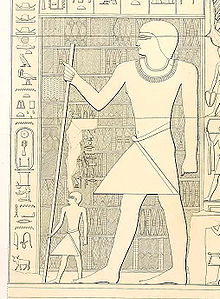Raschepses
Raschepses was a high ancient Egyptian official of the 5th Dynasty (around 2500 to 2350 BC). He held numerous important titles. At the end of his career he was promoted to vizier , which was the highest state office at the time.
Raschepses is best known for his mastaba , which is located north of the Djoser pyramid in Saqqara . The mastaba was discovered by the Lepsius expedition in the 19th century and was given the number LS 16. The rooms of the mastaba are decorated with reliefs. The underground burial chamber is painted. Decorated burial chambers did not appear until the end of the 5th dynasty. The burial chamber of Raschepses is perhaps the earliest with paintings. Raschepses officiated under King Djedkare . In his mastaba, as part of the wall decoration, there are copies of two letters that the king sent to the official.
Before his promotion to vizier, Raschepses was head of the scribe of the royal charter , head of the double barn and head of all the king's work . Raschepses was perhaps the son of the head of all the labor of King Netjerweser. The mastaba of the latter lies next to that of Rascheps. In this mastaba a Raschepses is mentioned as the son of the Netjerweser. However, Raschepses also had a son named Netjerweser, so that the Netjerweser was either the father or the son of Raschepses.
literature
- Nigel Strudwick: The Administration of Egypt in the Old Kingdom. KPI, London 1985, ISBN 0-7103-0107-3 , pp. 116-117.
- Hany Abdallah El-Tayeb: The burial chamber of Rashepses at Saqqara. In: Egyptian Archeology. No. 44, Spring 2014, pp. 8–9.
| personal data | |
|---|---|
| SURNAME | Raschepses |
| BRIEF DESCRIPTION | ancient Egyptian vizier |
| DATE OF BIRTH | around 2350 BC Chr. |
| DATE OF DEATH | around 2350 BC Chr. |
